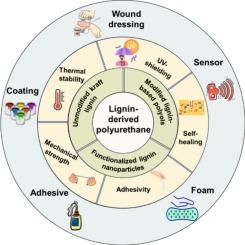Integrating advanced engineering strategies and multifunctional applications of sustainable lignin-based polyurethanes: A comprehensive review
IF 6.3
2区 化学
Q1 POLYMER SCIENCE
引用次数: 0
Abstract
Polyurethane (PU) is an important material widely used in numerous industrial products. Currently, the urgent need to mitigate petroleum dependency and environmental impacts has propelled lignin-based PU (LPU) as a sustainable alternative, capitalizing on lignin’s renewability, biodegradability, and non-competitive nature with food or fossil resources. This review critically evaluates engineering strategies for LPU synthesis, focusing on lignin modification (e.g., hydroxylation, fragmentation) and hybrid nanocomposite designs to optimize compatibility and reactivity. The tailored properties of LPU, including enhanced thermal stability, mechanical strength, and biodegradability, are systematically analyzed across diverse applications such as films, foams, adhesives, coatings, and biomedical materials. The discussions extends to the performances of LPU in UV-shielding, self-healing, and inflaming retarding, highlighting its industrial adaptability. Challenges in lignin heterogeneity, scalable processing, and interfacial compatibility are addressed, with future directions emphasizing lignin depolymerization, catalytic functionalization, and circular economy integration. By consolidating these insights, this review is expected to provide a strategic framework to advance the rational design and scalable production of high-performance LPU materials, paving the way for sustainable PU innovations.

综合先进的工程策略和可持续木质素基聚氨酯的多功能应用:综述
聚氨酯(PU)是一种广泛应用于众多工业产品的重要材料。目前,迫切需要减少对石油的依赖和对环境的影响,这促使木质素基PU (LPU)成为一种可持续的替代品,利用木质素的可再生、可生物降解性和与食物或化石资源的非竞争性。这篇综述对LPU合成的工程策略进行了批判性的评估,重点是木质素改性(例如,羟基化,碎片化)和混合纳米复合材料设计,以优化相容性和反应性。LPU的定制性能,包括增强的热稳定性、机械强度和可生物降解性,系统地分析了各种应用,如薄膜、泡沫、粘合剂、涂层和生物医学材料。讨论了LPU在紫外线屏蔽、自愈和阻燃方面的性能,突出了其工业适应性。解决了木质素异质性,可扩展处理和界面兼容性方面的挑战,未来的方向是强调木质素解聚,催化功能化和循环经济整合。通过巩固这些见解,本综述有望为推进高性能LPU材料的合理设计和可扩展生产提供战略框架,为可持续PU创新铺平道路。
本文章由计算机程序翻译,如有差异,请以英文原文为准。
求助全文
约1分钟内获得全文
求助全文
来源期刊

European Polymer Journal
化学-高分子科学
CiteScore
9.90
自引率
10.00%
发文量
691
审稿时长
23 days
期刊介绍:
European Polymer Journal is dedicated to publishing work on fundamental and applied polymer chemistry and macromolecular materials. The journal covers all aspects of polymer synthesis, including polymerization mechanisms and chemical functional transformations, with a focus on novel polymers and the relationships between molecular structure and polymer properties. In addition, we welcome submissions on bio-based or renewable polymers, stimuli-responsive systems and polymer bio-hybrids. European Polymer Journal also publishes research on the biomedical application of polymers, including drug delivery and regenerative medicine. The main scope is covered but not limited to the following core research areas:
Polymer synthesis and functionalization
• Novel synthetic routes for polymerization, functional modification, controlled/living polymerization and precision polymers.
Stimuli-responsive polymers
• Including shape memory and self-healing polymers.
Supramolecular polymers and self-assembly
• Molecular recognition and higher order polymer structures.
Renewable and sustainable polymers
• Bio-based, biodegradable and anti-microbial polymers and polymeric bio-nanocomposites.
Polymers at interfaces and surfaces
• Chemistry and engineering of surfaces with biological relevance, including patterning, antifouling polymers and polymers for membrane applications.
Biomedical applications and nanomedicine
• Polymers for regenerative medicine, drug delivery molecular release and gene therapy
The scope of European Polymer Journal no longer includes Polymer Physics.
 求助内容:
求助内容: 应助结果提醒方式:
应助结果提醒方式:


